2001年10月7日,以美国为首的联军对阿富汗塔利班和基地组织目标发动了空袭。几小时后,时任美国总统乔治•W•布什向全国人民发表讲话——当时的美国仍然深深地笼罩在“9•11”恐怖袭击事件的阴霾中。
“这场战争不是我们要求的,但我们会完成任务。今天的这场军事行动代号叫做‘持久自由’(Enduring Freedom)。”他说。“在接下来的几个月里,我们要有耐心,把它当作自己的一项优势——耐心等待更严格的安全措施出台,尽管这可能是一个漫长的过程;耐心等待并理解实现我们的目标需要时间;还要耐心看待在这期间可能出现的所有牺牲。”
将近20年后,美国军队——如今在役的都是一些在2001年袭击事件之后出生的年轻男女——从塔利班控制下的阿富汗撤出。人们的耐心几乎已经被磨得消失殆尽。
“现在,我已经是第四位指挥阿富汗战争的美国总统了。四人中,有两位是民主党人,两位是共和党人。” 本周,现任美国总统乔•拜登在全国讲话中说。“我不会把这个责任再传给第五任总统了。我不会误导美国人民,声称在阿富汗多坚持一会儿,就会让一切变得不同……我是美国总统,阿富汗的烂摊子就到我这里为止。”
这场“永远的战争”到底耗费了美国多少时间、金钱和生命?阿富汗战争是美国参战时间最长的战争,但和其他战争相比,也没有长很多。美国对伊拉克的军事干预——也是在“9•11”袭击事件之后发生的——还有越南战争,都花了差不多长的时间,并且两者也都是以相似的混乱僵局而告终,除了那些投资军事防御技术的人之外,没有一方能够称得上是赢家。
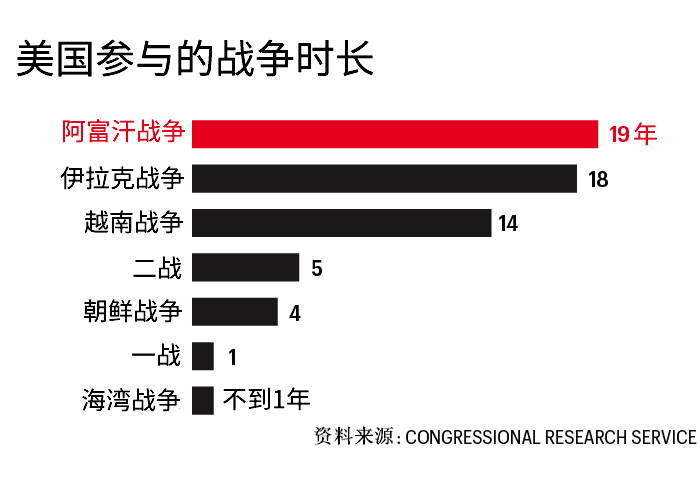
在阿富汗开展持久战的想法是由美国国防部前部长唐纳德•拉姆斯菲尔德提出的。2001年12月,在入侵阿富汗两个月后,他拒绝了塔利班提出的请降要求。他在当时表示:“我认为,双方不可能通过谈判的方式达成一致,最终谈成的结果一定是美国无法接受的。”
在2006年从政府部门辞职时,他警告美国不要从阿富汗撤军。“也许对某些人来说,考虑从痛苦、甚至是丑陋的战争的中优雅地退出,会令人感到欣慰。但敌人可不是这么想的。”他说。拉姆斯菲尔德在今年夏天逝世——就在战争结束的不久以前。
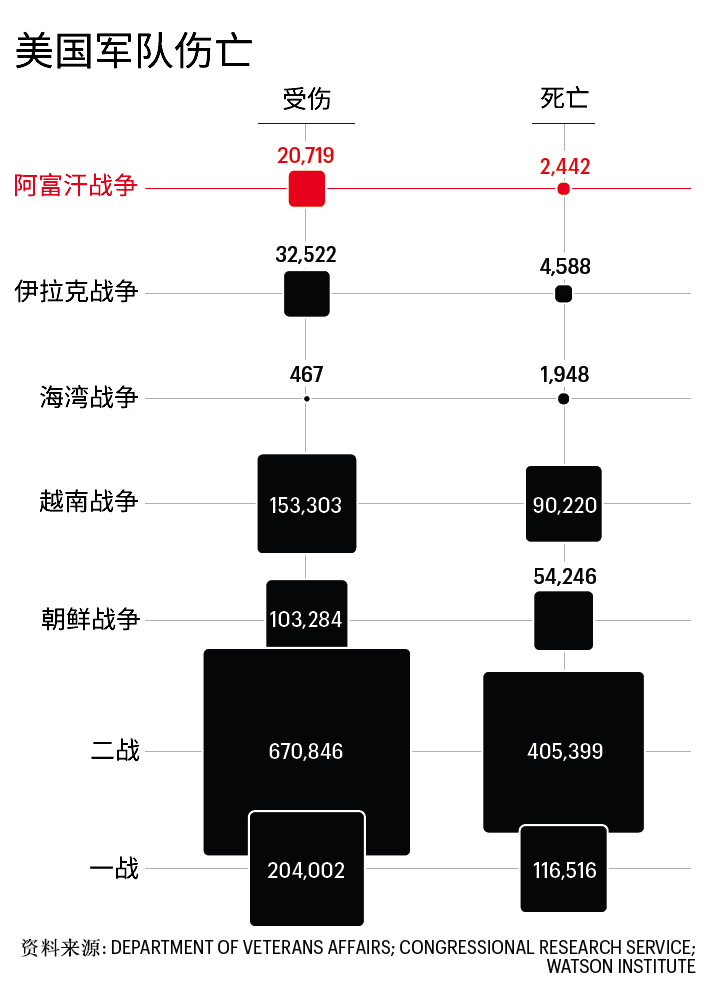
与此同时,阵亡士兵的数量不断增加,尽管和过去的战争相比还是少得多了。无人机技术和其他机器人战争的出现,使得军人的伤亡数量显著减少。这场持久战的本质主要集中于在阿富汗建立政权,因而军队改组后不怎么关注战斗本身,而是更多地关注阿富汗军队的训练。尽管如此,由于美军中没有出现大规模伤亡,在美国人过着寻常生活的时候,战火在阿富汗的土地上肆虐,而这在很大程度上被他们忽视了。
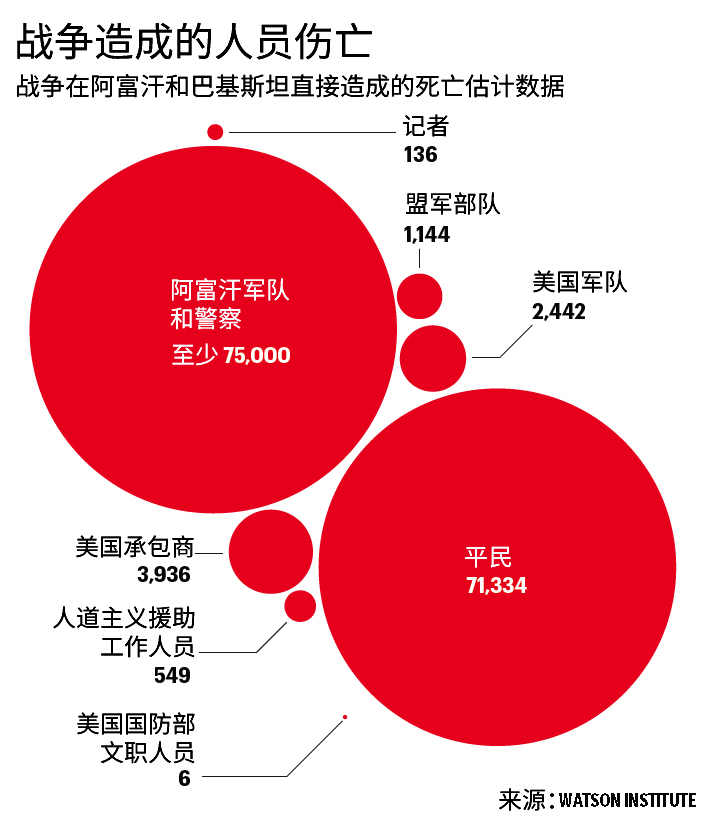 然而,阿富汗人的伤亡数量非常高。据估计,有75,000名阿富汗军人和警察直接死于战火,另外估计有71,334名平民直接死于战争。很难给出确切数字,因为五角大楼在2001年改变了政策,不再编制或发布死亡的平民人数。
然而,阿富汗人的伤亡数量非常高。据估计,有75,000名阿富汗军人和警察直接死于战火,另外估计有71,334名平民直接死于战争。很难给出确切数字,因为五角大楼在2001年改变了政策,不再编制或发布死亡的平民人数。
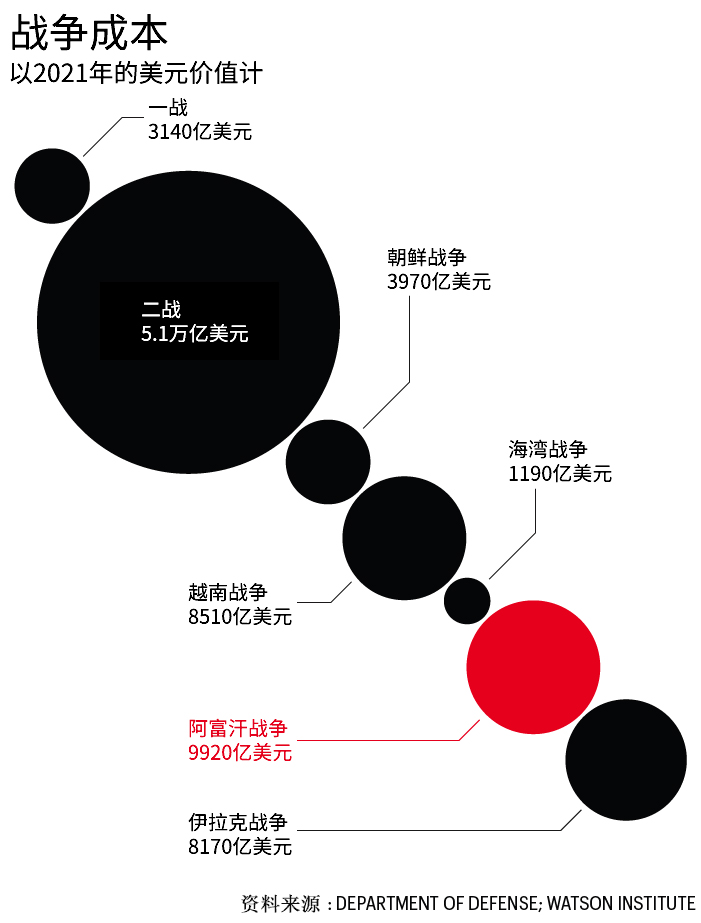
战争给美国带来的真实成本同样难以准确衡量,但可能接近1万亿美元。这些成本中很大一部分(约830亿美元)用来为阿富汗建设军队,并向他们提供美式军事武器。在美国撤军、阿富汗军队垮台后,这些武器、枪支、直升机和车辆有很大一部分落入了塔利班手中。
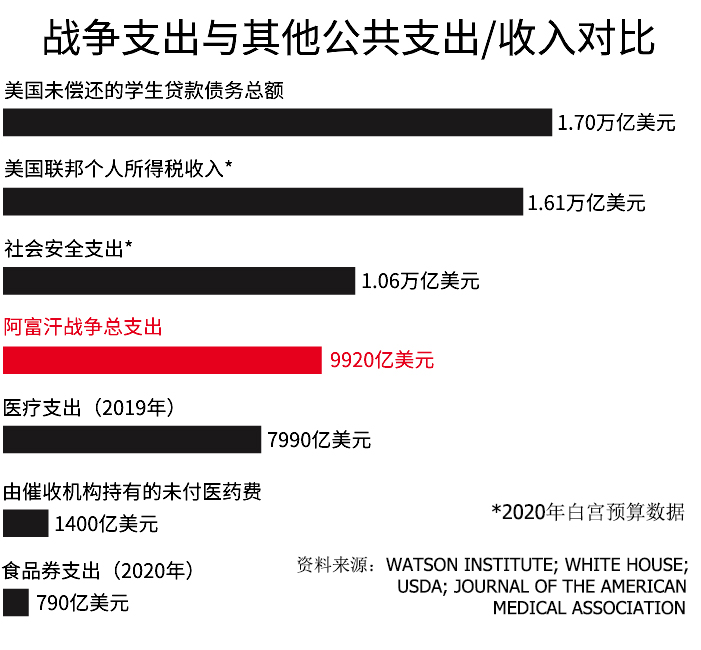
每年,战时支出都在联邦预算中占据大头。目前,美国的国防支出全球第一,并且比后11名国家的总和还多。根据这些数字计算,近20年来,美国每天在战争上的花费约为1.36亿美元,大约相当于在阿富汗的4,000万人身上、每人花费25,000美元。而这些成本可能还是被低估了。布朗大学(Brown University)的“战争的代价”项目(Costs of War Project)估计,如果把未来的退伍军人护理费和战争贷款的利息包括在内,真实成本将接近2.26万亿美元。(财富中文网)
编译:陈聪聪、杨二一
2001年10月7日,以美国为首的联军对阿富汗塔利班和基地组织目标发动了空袭。几小时后,时任美国总统乔治•W•布什向全国人民发表讲话——当时的美国仍然深深地笼罩在“9•11”恐怖袭击事件的阴霾中。
“这场战争不是我们要求的,但我们会完成任务。今天的这场军事行动代号叫做‘持久自由’(Enduring Freedom)。”他说。“在接下来的几个月里,我们要有耐心,把它当作自己的一项优势——耐心等待更严格的安全措施出台,尽管这可能是一个漫长的过程;耐心等待并理解实现我们的目标需要时间;还要耐心看待在这期间可能出现的所有牺牲。”
将近20年后,美国军队——如今在役的都是一些在2001年袭击事件之后出生的年轻男女——从塔利班控制下的阿富汗撤出。人们的耐心几乎已经被磨得消失殆尽。
“现在,我已经是第四位指挥阿富汗战争的美国总统了。四人中,有两位是民主党人,两位是共和党人。” 本周,现任美国总统乔•拜登在全国讲话中说。“我不会把这个责任再传给第五任总统了。我不会误导美国人民,声称在阿富汗多坚持一会儿,就会让一切变得不同……我是美国总统,阿富汗的烂摊子就到我这里为止。”
这场“永远的战争”到底耗费了美国多少时间、金钱和生命?阿富汗战争是美国参战时间最长的战争,但和其他战争相比,也没有长很多。美国对伊拉克的军事干预——也是在“9•11”袭击事件之后发生的——还有越南战争,都花了差不多长的时间,并且两者也都是以相似的混乱僵局而告终,除了那些投资军事防御技术的人之外,没有一方能够称得上是赢家。
在阿富汗开展持久战的想法是由美国国防部前部长唐纳德•拉姆斯菲尔德提出的。2001年12月,在入侵阿富汗两个月后,他拒绝了塔利班提出的请降要求。他在当时表示:“我认为,双方不可能通过谈判的方式达成一致,最终谈成的结果一定是美国无法接受的。”
在2006年从政府部门辞职时,他警告美国不要从阿富汗撤军。“也许对某些人来说,考虑从痛苦、甚至是丑陋的战争的中优雅地退出,会令人感到欣慰。但敌人可不是这么想的。”他说。拉姆斯菲尔德在今年夏天逝世——就在战争结束的不久以前。
与此同时,阵亡士兵的数量不断增加,尽管和过去的战争相比还是少得多了。无人机技术和其他机器人战争的出现,使得军人的伤亡数量显著减少。这场持久战的本质主要集中于在阿富汗建立政权,因而军队改组后不怎么关注战斗本身,而是更多地关注阿富汗军队的训练。尽管如此,由于美军中没有出现大规模伤亡,在美国人过着寻常生活的时候,战火在阿富汗的土地上肆虐,而这在很大程度上被他们忽视了。
然而,阿富汗人的伤亡数量非常高。据估计,有75,000名阿富汗军人和警察直接死于战火,另外估计有71,334名平民直接死于战争。很难给出确切数字,因为五角大楼在2001年改变了政策,不再编制或发布死亡的平民人数。
战争给美国带来的真实成本同样难以准确衡量,但可能接近1万亿美元。这些成本中很大一部分(约830亿美元)用来为阿富汗建设军队,并向他们提供美式军事武器。在美国撤军、阿富汗军队垮台后,这些武器、枪支、直升机和车辆有很大一部分落入了塔利班手中。
每年,战时支出都在联邦预算中占据大头。目前,美国的国防支出全球第一,并且比后11名国家的总和还多。根据这些数字计算,近20年来,美国每天在战争上的花费约为1.36亿美元,大约相当于在阿富汗的4,000万人身上、每人花费25,000美元。而这些成本可能还是被低估了。布朗大学(Brown University)的“战争的代价”项目(Costs of War Project)估计,如果把未来的退伍军人护理费和战争贷款的利息包括在内,真实成本将接近2.26万亿美元。(财富中文网)
编译:陈聪聪、杨二一
On Oct. 7, 2001, a U.S.-led coalition launched air strikes on Taliban and al Qaeda targets in Afghanistan. Hours later, President George W. Bush addressed a nation still reeling from the aftershocks of the Sept. 11 terrorist attacks.
“We did not ask for this mission, but we will fulfill it. The name of today's military operation is Enduring Freedom,” he said. “In the months ahead, our patience will be one of our strengths—patience with the long waits that will result from tighter security; patience and understanding that it will take time to achieve our goals; patience in all the sacrifices that may come.”
Nearly two decades later, the U.S. military—now serviced by some young men and women who were born after the 2001 attacks occurred—withdrew from Taliban-held Afghanistan. Patience had worn thin.
“I’m now the fourth American President to preside over war in Afghanistan. Two Democrats and two Republicans,” President Joe Biden said in a national address this week. “I will not pass this responsibility on to a fifth President. I will not mislead the American people by claiming that just a little more time in Afghanistan will make all the difference…I am President of the United States of America, and the buck stops with me.”
Just how much time, dollars, and lives have been spent on the "forever war"? The war in Afghanistan is the longest the U.S. has engaged in, but not by a lot. Involvement in Iraq—which also followed the 9/11 attacks—and Vietnam were similarly long and both ended in similar, confused stalemates with no winners to be declared except perhaps those who invested in defense technology.
The idea of the ongoing war in Afghanistan was promoted by former Secretary of Defense Donald Rumsfeld. In December 2001, two months after invading the country, he denied a plea by the Taliban to broker a surrender. “I do not think there will be a negotiated end to the situation that's unacceptable to the United States,” he said at the time.
Upon his exit from government in 2006 he warned against pulling out. “It may well be comforting to some to consider graceful exits from the agonies and, indeed, the ugliness of combat. But the enemy thinks differently,” he said. Rumsfeld passed away this summer, before the war ended.
Meanwhile, military deaths racked up, though nowhere near the level they had in past wars. The advent of drone technology and other robotic warfare led to a significant decrease in military casualties. The nature of the enduring war, which centered largely on nation-building, led to a restructured military with less focus on fighting and more on training the Afghan army. Still, the lack of massive American casualties allowed the war to rage on in the background of American life, largely unnoticed.
Civilian casualties in Afghanistan, however, were extraordinarily high. An estimated 75,000 Afghan military and police officers perished in direct war deaths and an additional estimated 71,334 civilians died directly because of war. It’s difficult to give exact numbers because the Pentagon changed its policy in 2001 and stopped compiling or releasing civilian body counts.
The true costs of the war to the U.S. are similarly difficult to measure, but they likely neared $1 trillion. A large portion of those costs—about $83 billion—came from building and supplying Afghan forces with U.S. military weapons. After the U.S. withdrawal and the collapse of Afghanistan’s military, a significant portion of those weapons, guns, helicopters, and vehicles fell into the hands of the Taliban.
Wartime spending ate up a significant portion of the federal budget each year, and the United States currently spends more on defense than the next 11 countries combined. By those calculations, the United States spent about $136 million dollars per day on the war every day for nearly 20 years, as well as a total of about $25,000 for each of the 40 million people living in Afghanistan. And these costs may be low estimates. Brown University’s Costs of War Project estimates the true cost to be closer to $2.26 trillion when future veteran care and interest on war borrowing are included.






